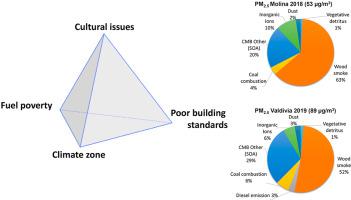Atmospheric Pollution Research ( IF 4.5 ) Pub Date : 2021-02-20 , DOI: 10.1016/j.apr.2021.02.011 Héctor Jorquera , Ana María Villalobos , James J. Schauer

|
Cities in southern Chile are facing high levels of PM2.5 because of wood burning pollution. We quantify the contribution of wood smoke to fine particles in two mid-size cities: Molina and Valdivia, located in different climate zones. The sampling campaigns were carried out during austral winter (July to September) in 2018 (Molina) and 2019 (Valdivia). 24-h filter samples were analyzed for carbonaceous compounds, secondary ions, metals, and particle-phase organic molecular markers. Average winter concentrations of PM2.5 were 53 ± 32 μg/m3 (average ± standard deviation) in Molina and 89 ± 55 μg/m3 in Valdivia. The major component of fine particles was organic matter, representing more than 70% of PM2.5. Concentrations of organic molecular markers were used in a receptor model (US EPA CMB8.2) to identify and quantify primary sources of PM2.5. The major source of PM2.5 was wood smoke, which accounted for 41.55 ± 9.77 μg/m3 (62.9 ± 15.3%) in Molina and 43.65 ± 24.06 μg/m3 (51.7 ± 21.1%) in Valdivia. Secondary organic aerosols (SOA) generated from inefficient wood burning, contributed 20.4 ± 17.7% in Molina and 28.9 ± 27.6% in Valdivia. Secondary inorganic ions and dust are minor sources of PM2.5. The total contribution of wood smoke (adding primary wood smoke and SOA) could be as much as 83% in Molina and 81% in Valdivia, during the winter season.
中文翻译:

智利的燃木污染:两个中型城市的故事
智利南部的城市由于燃木污染而面临PM 2.5的高水平。我们对位于不同气候区的两个中型城市:莫利纳和瓦尔迪维亚的木质烟雾对细颗粒的贡献进行了量化。采样活动是在2018年(莫利纳州)和2019年(瓦尔迪维亚)的南方冬季(7月至9月)进行的。分析了24小时过滤器样品中的碳质化合物,次级离子,金属和颗粒相有机分子标记。冬季的PM 2.5的平均浓度在莫利纳(Molina)为53±32μg/ m 3(平均值±标准偏差),在瓦尔迪维亚(Valdivia )为89±55μg/ m 3。细颗粒的主要成分是有机物,占PM 2.5的70%以上。在受体模型(US EPA CMB8.2)中使用了有机分子标记物的浓度,以鉴定和量化PM 2.5的主要来源。PM 2.5的主要来源是木烟,其在莫利纳(Molina)占41.55±9.77μg/ m 3(62.9±15.3%),在瓦尔迪维亚占43.65±24.06μg/ m 3(51.7±21.1%)。木材燃烧效率低下产生的次级有机气溶胶(SOA)在莫利纳(Molina)和瓦尔迪维亚(Valdivia)占20.4±17.7%。二次无机离子和粉尘是PM 2.5的次要来源。在冬季,莫利纳和瓦尔迪维亚的木烟总贡献(加上原始木烟和SOA)可能高达83%,而在瓦尔迪维亚则高达81%。


























 京公网安备 11010802027423号
京公网安备 11010802027423号